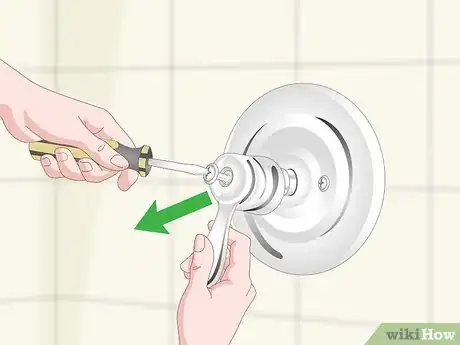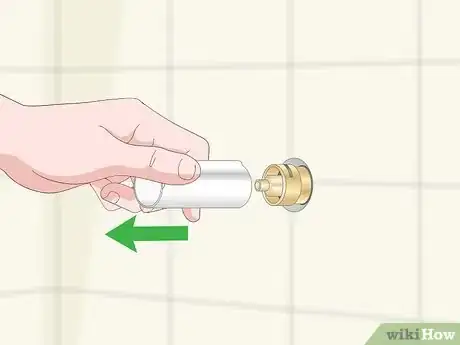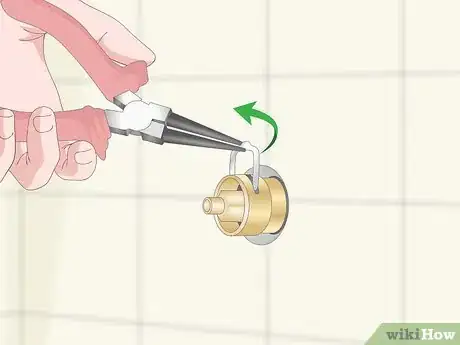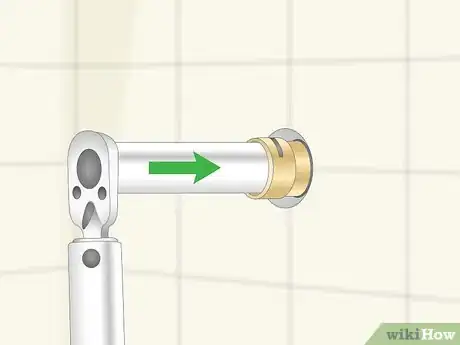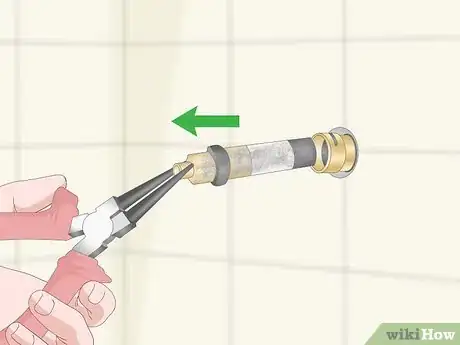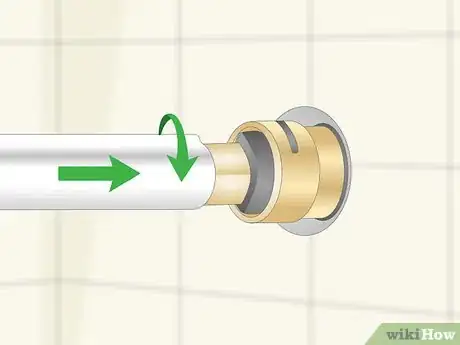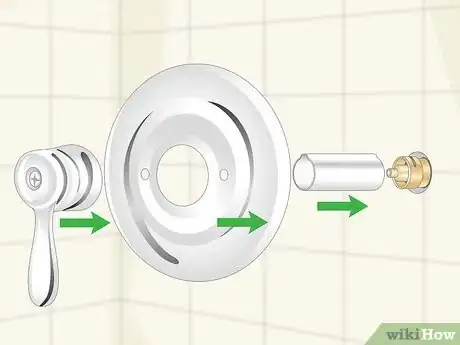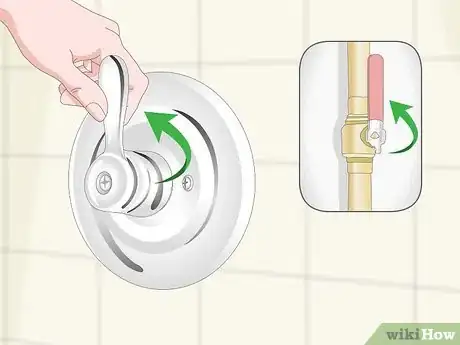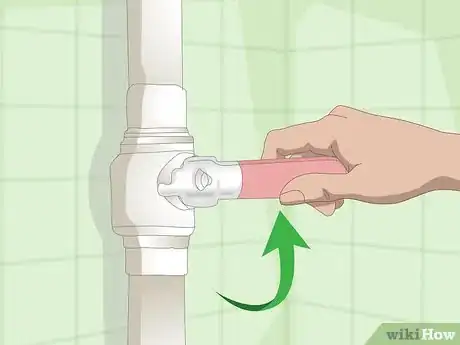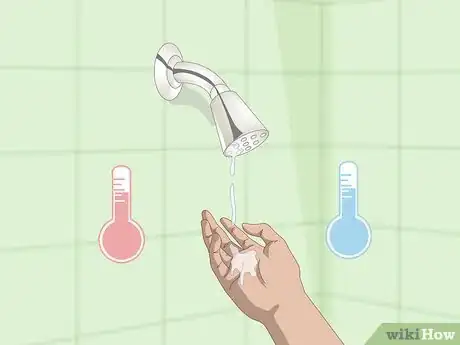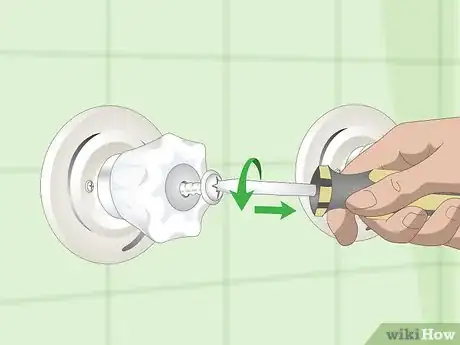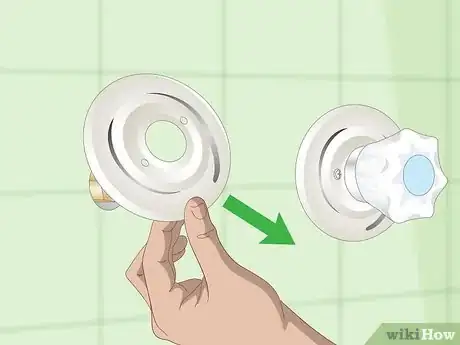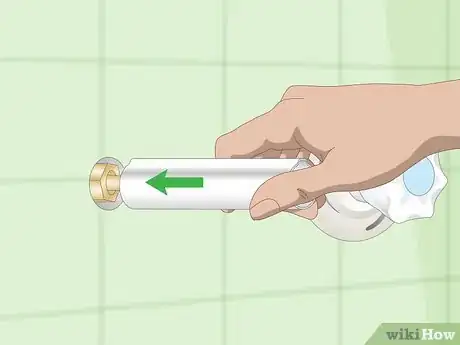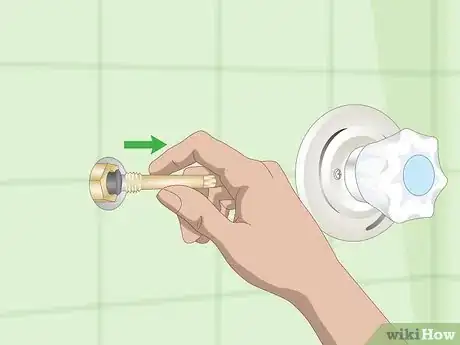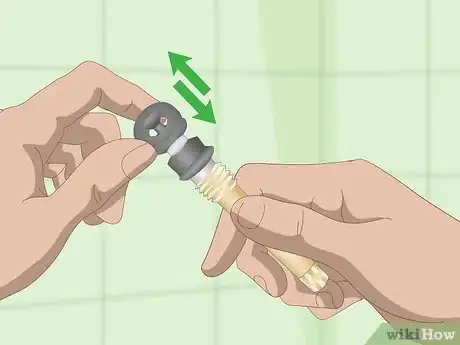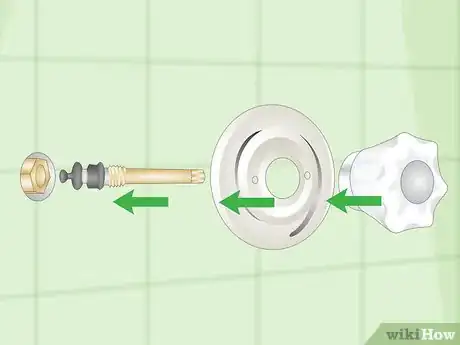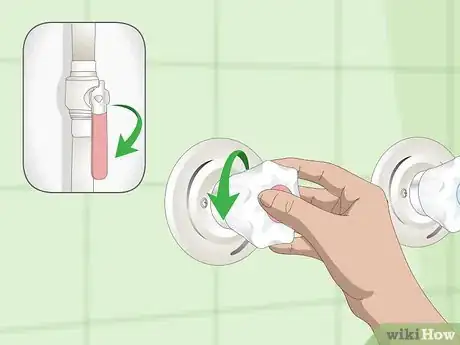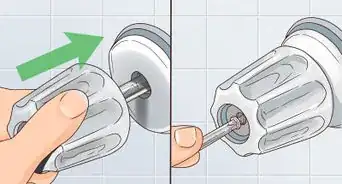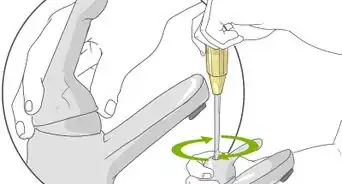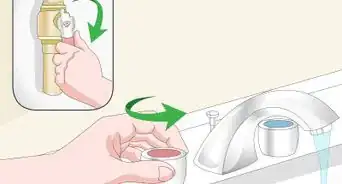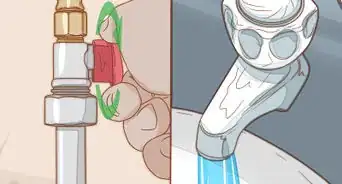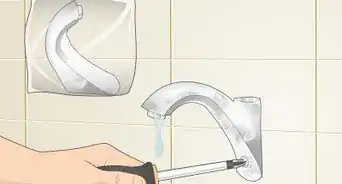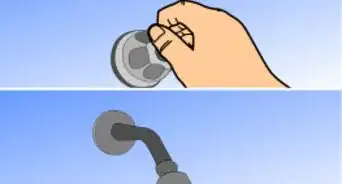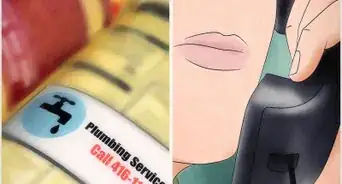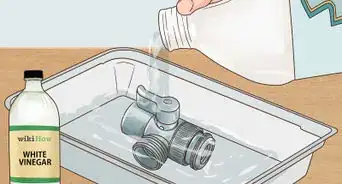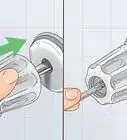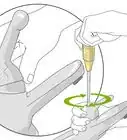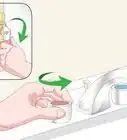This article was co-authored by David Balkan and by wikiHow staff writer, Danielle Blinka, MA, MPA. David Balkan is a Professional Plumber, CEO of Balkan Sewer and Water Main Service, and President of Balkan Sewer and Drain Cleaning. As a hands-on owner of these companies for over 40 years, David is knowledgeable about water service lines, sewers, and drain line issues. David is a Committee Chairman of the Master Plumbers Council and has sat on the Executive Committee of the Sub Surface Plumbers Association of New York for over 30 years. His knowledge and solution-oriented approach contributed to Balkan Sewer and Water Main Service being the largest and most trusted service in New York City and the recipient of the 2017 Angie’s List Super Service Award.
There are 12 references cited in this article, which can be found at the bottom of the page.
This article has been viewed 695,442 times.
A leaking shower faucet can be both annoying and costly, as it will likely lead to higher water bills. Fortunately, you can fix your leaky shower faucet yourself with a few tools and supplies. If you have a single-handle shower faucet, you’ll need to replace the cartridge in your valve. For a 2-handle shower faucet, replace the washer in the handle on the side that’s leaking. However, you may need to call a professional plumber if your DIY fix doesn't work.
Steps
Installing a New Cartridge in a Single-Handle Faucet
-
1Turn off your water valve before beginning. Your water valve controls the flow of water to your shower. It may be located in your bathroom or your basement. In some cases, it's behind a panel near your shower. Once you locate the valve, turn the knob clockwise to turn off the water.[1] [2]
- You may find the panel that houses your water valve in the room next to your bathroom. It may even be in a closet.
-
2Remove your shower handle using a screwdriver. The screw will be in the center of a knob handle or on the side of a curved handle. Choose a screwdriver that fits into the screw head. Then, carefully turn the screwdriver counter-clockwise to loosen it. Pull out the screw and set it aside to reuse when you replace the shower handle.[3]
- Your handle could have more than 1 screw, so make sure you remove all of them.
- If your handle won’t come off, try heating it with a hair dryer. Set the heat to high, then blow the hot air onto your handle for 1 minute. Drape a towel over the handle to protect your hand from the heat. Then, try to pull off the handle.[4]
Tip: While each shower faucet is different, most will come off with a screwdriver. If you’re having trouble removing yours, you may need to consult a professional plumber.
Advertisement -
3Use your screwdriver to remove the faceplate. The faceplate is the metal piece that's behind your handle. Fit the screwdriver tip into the screws on the faceplate. Next, turn it counter-clockwise to loosen the screws. Set the screws aside for later, then carefully pull off the faceplate and set it aside.[5]
- The faceplate may stick to the tile or shower wall. If this happens, gently wiggle it until it comes free.
-
4Pull the metal sleeve off of the shower valve that’s behind the faceplate. The shower valve looks like part of a metal pipe that connects to your shower handle. It will have a metal sleeve that covers the end of the valve. Use your hands to carefully remove this sleeve, then set it aside for later.[6]
- This sleeve is called an escutcheon. If you look for one at the hardware store, this is what you’ll need to ask for.
Variation: Some escutcheons screw onto the valve, so you may need to unscrew it. If it screws on, you should see threads on your valve. Twist the escutcheon counter-clockwise to loosen it.
-
5Use pliers to remove the locking clip if your valve has one. Look for the locking clip on the top of your valve. It will look like a metal rod, and the end should stick out of the top. If you see one, use a pair of needle-nose pliers to carefully pull it out. Set it to the side so you can replace it when you’re finished installing the new cartridge.[7]
- The locking clip should be visible on the top of the valve. They aren’t present on all valves, so don’t worry if you don’t see one.
- You may need to use a screwdriver or awl to pry up the clip.[8]
-
6Fit a deep well socket wrench over the valve cartridge. The cartridge looks like a long cylinder with a metal rod sticking out of the top. Choose a deep well socket wrench that’s the right size for your cartridge, then slide it over the cartridge inside the valve. Turn it counter-clockwise to make sure it grips the cartridge. If the socket is too loose, choose the next size down.[9]
- A deep well socket wrench is a wrench that has a long metal tube fitted onto the end so you can remove nuts or screws that are embedded inside a hole.
- If you don’t have a deep well socket wrench, you can pick one up at your local hardware store or online. Most deep well socket wrenches come with a range of sockets in different sizes so you can find the 1 that fits your nut.
- You can also find tools that are called “cartridge pullers.” These will also remove your cartridge. However, make sure you get the cartridge puller made for your brand of faucet.[10]
- The cartridge is the part of the valve that controls the flow and temperature of the water.
-
7Turn the wrench counterclockwise to remove the cartridge. Use the handle to slowly turn the wrench, which will loosen the cartridge. Keep turning until the cartridge feels like it’s free.[11]
- The cartridge may come out in the deep well socket wrench. However, it’s normal for it to remain in the valve after you pull out the wrench. That's okay because you can remove it by hand.
-
8Use your needle-nose pliers to pull out the cartridge. Latch onto the end of the cartridge using your needle-nose pliers. Then, carefully pull the cartridge from inside the valve.[12]
- If you don’t have your replacement cartridge yet, take the old cartridge to your local hardware store to find a match. For an easy option, show it to an experienced store associate and let them find the match for you.[13]
-
9Install a new cartridge into the valve by turning it clockwise. Slide the new cartridge into the empty valve. Then, put your deep well socket wrench over the cartridge and turn it clockwise. Stop when the cartridge feels like it’s tight.[14]
-
10Replace your valve sleeve, faceplate, and shower handle. Slide the valve sleeve (escutcheon) back over the valve, then put the faceplate back into place. Use your screwdriver to secure the faceplate against the shower wall. Finally, screw your shower handle back into place.[15]
- If your valve had a locking clip, don’t forget to put it back on before you replace the valve sleeve.
-
11Turn your water valve back on and test your shower. Turn the knob on your water valve counter-clockwise so the water will come back on. Then, turn on the shower faucet to see if it works correctly. Finally, turn off the shower and make sure the leak is gone.
- If your shower is still leaking, you’ll need to call a professional plumber to fix it.
Replacing the Washer in a 2-Handle Faucet
-
1Switch off the water valve before you get started. The water valve controls the flow of water to your shower faucet, and it’s often located in your bathroom or basement. You may find it behind a panel that’s located on the other side of your shower. Turn the knob on your shower valve clockwise to shut off the water.[16] [17]
- If you’re having trouble finding your shower valve, look in the room next to your shower. You may find the panel there.
-
2Feel the water coming from the faucet to see if it’s hot or cold. Put your hand under the leak to check the temperature of the water. If it’s cold, then it’s likely the cold faucet that’s leaking. On the other hand, hot water means the hot side is likely leaking.[18]
- It’s possible that both sides are leaking. If this is the case, you can replace the washer on the second side if the leak doesn't go away after you replace the first washer.
-
3Use a screwdriver to remove the shower handle on the leaky side. Look for the screw in the center of the shower handle. Fit your screwdriver into the screw that holds the shower handle in place. Then, turn your screwdriver counter-clockwise to loose the screw and remove it. Finally, set the screw and the handle aside for later.[19]
Tip: If your handle has a decorative plate over the screw, you’ll need to pry this up first. Use a flathead screwdriver to pull it free.
-
4Remove the metal faceplate that attaches to the shower wall. This is the metal piece that goes under the handle. Look inside the faceplate to see if it has threads, which it likely will. Gently unscrew the metal plate by turning it counter-clockwise. When it comes off, set it aside until you’re ready to put it back on.[20]
- This is also called an escutcheon.
-
5Slide a deep well socket wrench over the metal stem and onto the nut. The nut will be located deep inside your wall, so you'll need a deep well socket wrench to reach it. Choose the size that looks right, then slide it over the metal stem. Secure the end of the wrench over the valve nut that’s at the base of the stem.[21]
- A deep well socket wrench is a wrench with a long metal tube on the end. It allows you to reach nuts that are embedded inside a structure.
- You can find a deep well socket wrench at a local hardware store or online. They're often sold in sets so you can choose the right size socket for your needs.
- To make sure it’s the right size, turn the wrench counter-clockwise to make sure it’s gripping the nut.
-
6Unscrew the valve nut and set it aside. Turn the wrench counter-clockwise until the nut comes free. Then, remove the wrench and the nut from the valve. Set the nut aside so you can put it back on later.[22]
- Your nut should stick in the wrench when you pull it out.
-
7Pull the metal stem out of the wall and put it aside. The metal stem is the part of your faucet that the handle turns. Use your fingers to carefully remove the metal stem. It should slide out easily now that the nut isn’t holding it in place. Set the metal stem to the side so you can reuse it.[23]
-
8Remove the old rubber washer and install a new rubber washer. Use a pair of needle-nose pliers to pull the old rubber o-ring washer from around the valve. It should easily come off because it’s just pressed onto the valve. Discard the old washer, then press a new rubber o-ring washer over the valve. Line it up in the exact place as the old one.[24]
- Make sure your replacement rubber washer is the same size as the 1 that's already there. This will ensure a proper fit.
- It's a good idea to buy a kit that has a variety of washer sizes in it, since you won't know exactly what size you need until you take apart the faucet.[25]
- Coat the new washer in heat-proof faucet grease to improve the seal.
-
9Replace your metal stem, faceplate, and shower handle. Slide the metal stem back into place. Then, put the nut into your deep well socket wrench. Slide the wrench over the metal stem and replace the nut by turning it clockwise. Next, put the faceplate against the wall and turn it to secure it in place. Finally, screw the shower handle back onto the metal stem.[26]
Variation: If your metal stem is damaged or worn down, you can purchase a replacement from your local hardware store for about $15. Bring your old stem to the store to help you find the correct match.
-
10Turn on your water valve and test the faucet. Turn the knob on your water valve counter-clockwise so the water will come back on. Next, turn on your shower faucet to make sure that the water is running correctly. Finally, turn off the faucet and check that the leak is fixed.[27]
- If the leak isn’t fixed, try replacing the washer on the other side. If this doesn’t work, you’ll need to call in a professional plumber.
Expert Q&A
-
QuestionHow do I stop my shower faucet from dripping?
 David BalkanDavid Balkan is a Professional Plumber, CEO of Balkan Sewer and Water Main Service, and President of Balkan Sewer and Drain Cleaning. As a hands-on owner of these companies for over 40 years, David is knowledgeable about water service lines, sewers, and drain line issues. David is a Committee Chairman of the Master Plumbers Council and has sat on the Executive Committee of the Sub Surface Plumbers Association of New York for over 30 years. His knowledge and solution-oriented approach contributed to Balkan Sewer and Water Main Service being the largest and most trusted service in New York City and the recipient of the 2017 Angie’s List Super Service Award.
David BalkanDavid Balkan is a Professional Plumber, CEO of Balkan Sewer and Water Main Service, and President of Balkan Sewer and Drain Cleaning. As a hands-on owner of these companies for over 40 years, David is knowledgeable about water service lines, sewers, and drain line issues. David is a Committee Chairman of the Master Plumbers Council and has sat on the Executive Committee of the Sub Surface Plumbers Association of New York for over 30 years. His knowledge and solution-oriented approach contributed to Balkan Sewer and Water Main Service being the largest and most trusted service in New York City and the recipient of the 2017 Angie’s List Super Service Award.
Professional Plumber & CEO of Balkan Sewer & Water Main Try replacing the washers behind the faucet. Just be sure to pick up a kit with an assortment of washers since you won't really know what you need until you take it apart.
Try replacing the washers behind the faucet. Just be sure to pick up a kit with an assortment of washers since you won't really know what you need until you take it apart. -
QuestionI have a three handle faucet for my bathtub. The hot water leaks from the handle when it is turned on. How do I fix this?
 Community AnswerWhichever handle it leaks from, the packing is worn. You'll need to take the valve apart to replace the packing or O-ring.
Community AnswerWhichever handle it leaks from, the packing is worn. You'll need to take the valve apart to replace the packing or O-ring. -
QuestionWhy is my shower leaking after I changed the valves?
 Community AnswerIf you replace the valves and it still leaks, that usually means there is damage to the seat. You may need a complete new faucet install.
Community AnswerIf you replace the valves and it still leaks, that usually means there is damage to the seat. You may need a complete new faucet install.
Things You’ll Need
Installing a New Cartridge in a Single-Handle Faucet
- Gloves (optional)
- Screwdriver
- Needle-nose pliers
- Deep well socket wrench
- Cartridge pullers (optional)
- New cartridge
Replacing the Washer in a 2-Handle Faucet
- Gloves (optional)
- Screwdriver
- Deep well socket wrench
- Needle-nose pliers
- New washer
- Heat-proof faucet grease
- New metal stem (optional)
Warnings
- If your shower is leaking behind the wall or your valve is damaged, you’ll need to call in a professional plumber to repair or replace the valve.[28]⧼thumbs_response⧽
References
- ↑ David Balkan. Professional Plumber & CEO of Balkan Sewer & Water Main. Expert Interview. 23 February 2021.
- ↑ https://www.familyhandyman.com/plumbing/faucet-repair/how-to-fix-a-dripping-shower/
- ↑ https://www.youtube.com/watch?v=pNAovnD_Iks&feature=youtu.be&t=6
- ↑ https://www.familyhandyman.com/plumbing/faucet-repair/how-to-fix-a-dripping-shower/
- ↑ https://www.youtube.com/watch?v=pNAovnD_Iks&feature=youtu.be&t=19
- ↑ https://www.youtube.com/watch?v=pNAovnD_Iks&feature=youtu.be&t=59
- ↑ https://www.youtube.com/watch?v=pNAovnD_Iks&feature=youtu.be&t=65
- ↑ https://www.familyhandyman.com/plumbing/faucet-repair/how-to-fix-a-dripping-shower/
- ↑ https://www.youtube.com/watch?v=pNAovnD_Iks&feature=youtu.be&t=68
- ↑ https://www.familyhandyman.com/plumbing/faucet-repair/how-to-fix-a-dripping-shower/
- ↑ https://www.youtube.com/watch?v=pNAovnD_Iks&feature=youtu.be&t=68
- ↑ https://www.youtube.com/watch?v=pNAovnD_Iks&feature=youtu.be&t=87
- ↑ https://www.youtube.com/watch?v=pNAovnD_Iks&feature=youtu.be&t=92
- ↑ https://www.familyhandyman.com/plumbing/faucet-repair/how-to-fix-a-dripping-shower/
- ↑ https://www.familyhandyman.com/plumbing/faucet-repair/how-to-fix-a-dripping-shower/
- ↑ David Balkan. Professional Plumber & CEO of Balkan Sewer & Water Main. Expert Interview. 23 February 2021.
- ↑ https://www.familyhandyman.com/plumbing/faucet-repair/how-to-fix-a-dripping-shower/
- ↑ https://www.youtube.com/watch?v=y_DWX2oTYxo&feature=youtu.be&t=7
- ↑ https://www.bobvila.com/articles/leaking-shower-head/
- ↑ https://www.bobvila.com/articles/leaking-shower-head/
- ↑ https://www.bobvila.com/articles/leaking-shower-head/
- ↑ https://www.bobvila.com/articles/leaking-shower-head/
- ↑ https://www.bobvila.com/articles/leaking-shower-head/
- ↑ https://www.bobvila.com/articles/leaking-shower-head/
- ↑ David Balkan. Professional Plumber & CEO of Balkan Sewer & Water Main. Expert Interview. 23 February 2021.
- ↑ https://www.bobvila.com/articles/leaking-shower-head/
- ↑ https://www.bobvila.com/articles/leaking-shower-head/
- ↑ https://www.youtube.com/watch?v=pNAovnD_Iks&feature=youtu.be&t=106
About This Article
To fix a leaky single-handle faucet in your shower, start by turning off the water supply to your bathroom. Then, use a screwdriver to take the shower handle off. Once that's off, unscrew the faceplate, which should be located right behind where the handle was. Next, pull off the metal sleeve of the shower valve that's behind the faceplate, and use pliers to remove the locking clip that's on top of the valve. After you take that off, use a socket wrench and needle nose pliers to remove the valve cartridge. Finally, install a new cartridge into the valve, and reassemble everything before turning the water back on. To learn how to fix a double-handle shower faucet, scroll down!


